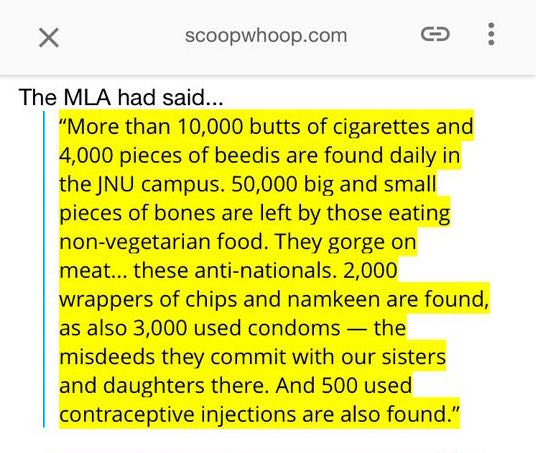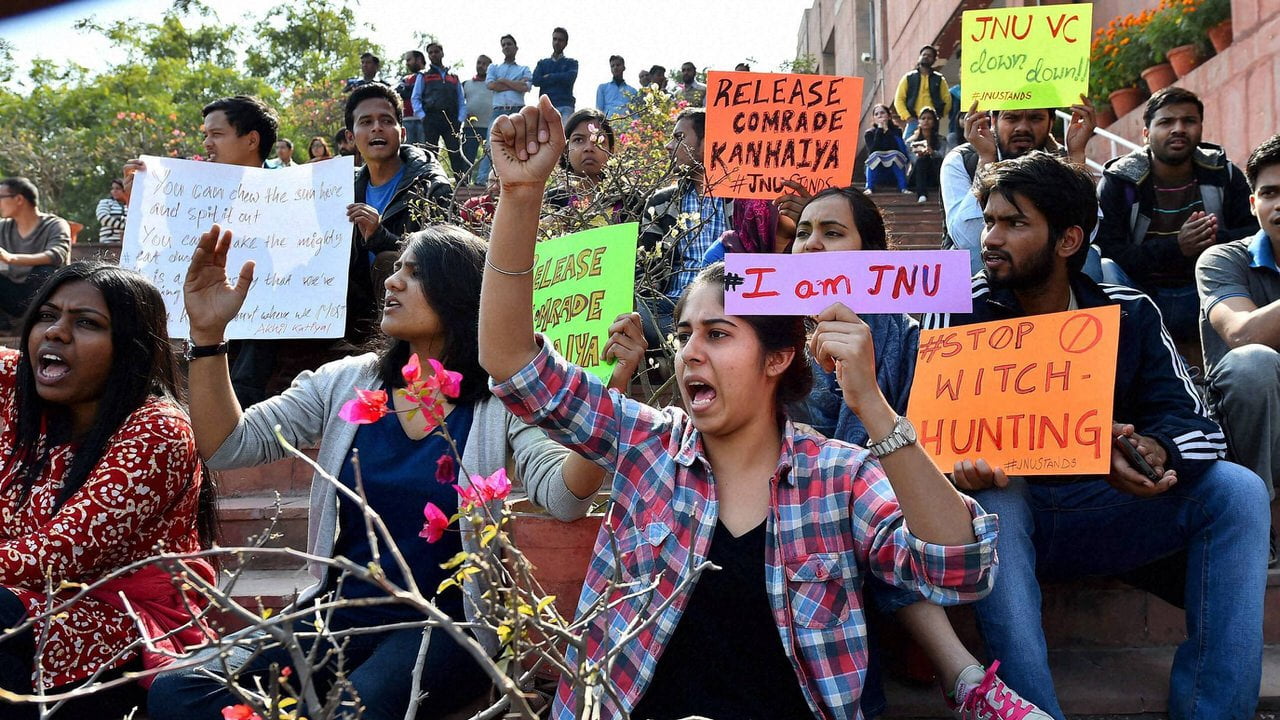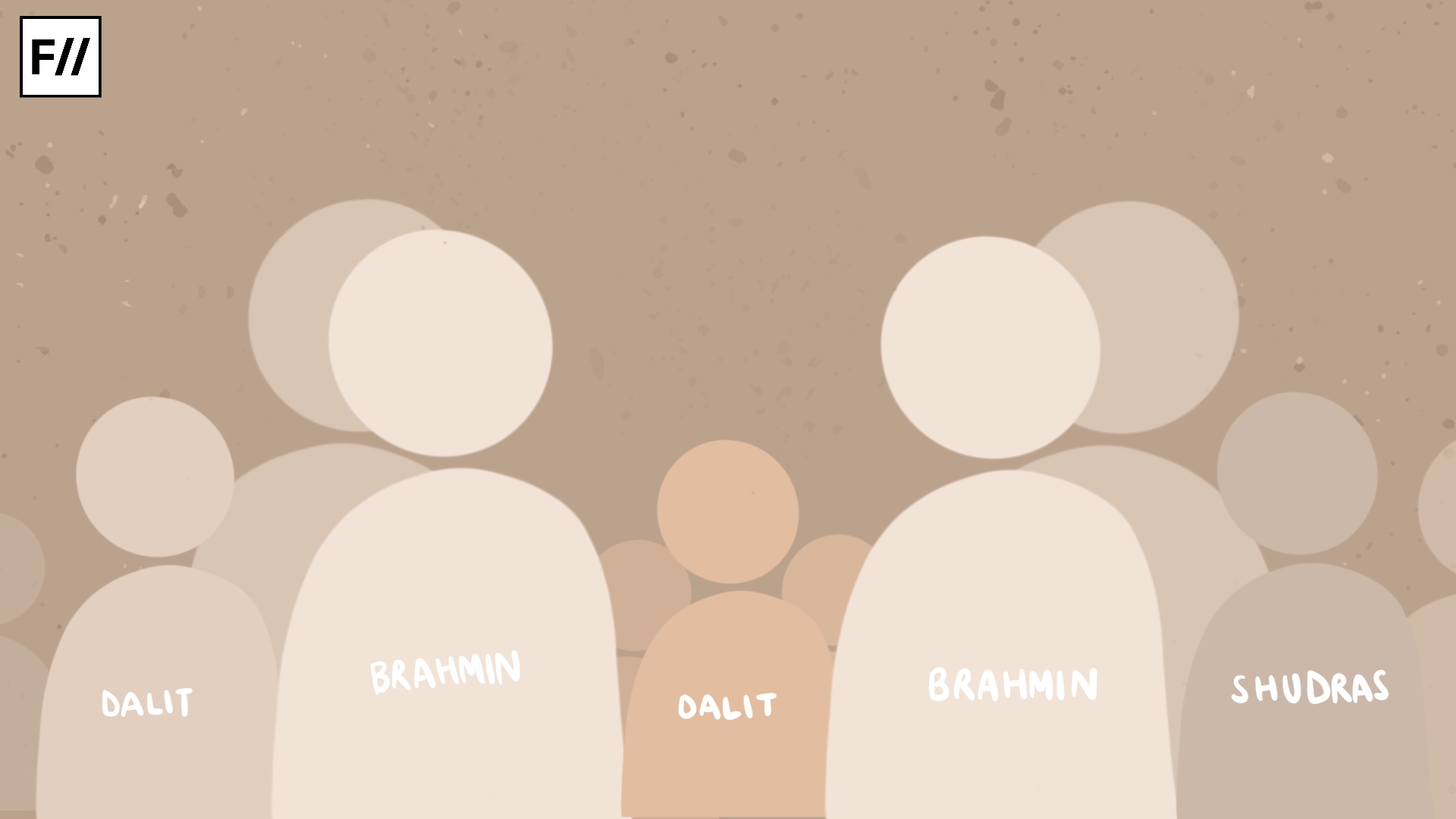The demystification of the ‘JNU woman’ didn’t seem like a task I was going to burden myself with, because frankly, there is little to offer as ‘defense’. When women start asserting themselves, the existing power structures tremble in fear and in their insecurity, go on to create crafty lies and truths. The right-wing patriarchal imagination too, out of desperation, is seen constructing a narrative of fear of the ‘free-willing’ JNU women, the ‘incarnates of evil’ sexual libertines.
The recent flurry of reports around JNU women being ‘found’ in the rooms of men, refreshes the author’s memory. A patterned reporting style has been long observed when talking about ‘other women’ here, JNU women as the Other. A slanderous tone forms and informs the political debate. You are forced to enter the debate from a point where you either have to prove that women, in general and also JNU women, are pious/pure political subjects/beings, or you have to make a #NotAllJNUWomen to pat yourself on the back and place yourself ‘above’ them. Or you could recognize the fallacy of such a structuring of the debate and argue that they are owning their bodies and sexuality and there’s no problem with that! When you do that latter, you actualise the fear of the ‘other’ even more. You open up a real possibility of the worst nightmare of the Hindu-patriarchal family collapsing coming true.That’s havoc!
When women start asserting themselves, the existing power structures tremble in fear and in their insecurity, go on to create crafty lies and truths.
It is being insinuated that women of JNU engage in (haw!) ‘pre-marital/non-marital’ sex. In a society where women’s sexual expression and identity are confined in the cages of ‘sanctimonious wedlock’, an alternate imagination is bound to threaten a cultural pattern, deeply rooted in narrow notions of ‘Indian tradition’. Obviously, such a woman is now ‘crossing the threshold’ of acceptability and respectability and hence is un-ideal in the narrow regimes of patriarchal power.

Translation: 13 outsider women found in JNU boys hostels, who had come to do ‘that kind of work’.
So the best thing to do is to use her instrumentally as an ‘exemplar’ as the ‘other/deviant’. By doing that, good Indian women would scorn at the sight of such a woman who dares to embrace her sexuality, lest they too be seen as condoning sexual liberation (OMG! Free Sex!). When the very idea of sexual liberation is tied up with the crisis of masculinity or shattering of patriarchy, and as an inherent vice, then JNU women will obviously be vilified for the refusal to submit to the existing apparatus of sexual control. An honest reason for the growing targeting of JNU women students would be:
“JNU women need to be controlled! We need to come up with stricter rules ensuring spatial segregation to check their rebelliousness. The ‘empowering project’ of the government and the society wants a facile outward ‘projection’ of ‘women’s progress and nothing more concrete than that which endangers their own power”.
Women are encouraged to assimilate in the existent casteist/classist system but not bring their politics of social transformation to the table. They must participate but not in their own terms, but rather as ‘handmaidens’ of the system, representationally as women but not as feminists.
The absence of an uncritical compliance with the tenets of capitalist-Brahmanical-patriarchal-social order creates the ‘necessity’ and justification for a ‘counter narrative’, one that the custodians of culture take upon themselves. An image, that in the minds of the ‘objective-desh-bhakt media’, through which they think they are only offering a mirror to society – by giving us a count of condoms being ‘found’ in JNU or telling us the number of girls that were ‘found’ in the men’s hostel. They seem to be convinced that they are ‘merely’ exposing the ‘true face’ of the ‘libtard-sickular-antinational-commie’ (as if they are all the same) Adda that is JNU.
JNU women will obviously be vilified for the refusal to submit to the existing apparatus of sexual control.
In effect, what they do is create conditions for making the space more hostile for both JNU women and women who ‘seem’ like they are from JNU. I hold no sympathy for such a media which is blinded by its own ignorance and irresponsibly constructs a fictitious discourse! They are not all ‘simple journalists’ trying to do their job, there are agents of big sharks that have invested in influencing the setting of the national agenda. Therefore, to look at the media reports as pure outcomes of ignorance, or as a reflection of our failures gender sensitization on ‘ground’, is only half the story as it assumes a ‘neutrality’ of the media which doesn’t actually exist.
It is visible that the media reports cases concerning women in a voyeuristic way, embedded in patriarchal signification and symbolism, often times reveal gory details that satisfy a perverse fantasy. By using frames and language that map the news, responsible for structuring public debate – the media chooses to write stories from the vantage point of the consumer – the consumer who wants to read a reified narrative of the dominant discourse. The media ends up repeating the narrative of powerful, in the language that is exclusionary.
It is the consumption patterns that determine reporting and not the responsibility to frame and set political agenda that dictates terms of reporting on women. The consumer wants to read a suggestive news piece insinuating that women of JNU are ‘sleeping around’, ‘dancing naked’, ‘ having free sex’, etc. It strokes the hetero-patriarchal imagination of the prohibited fantasy – that which may not even exist – JNU becomes an island every man wants to privately fantasize about and also shame publicly. Desperate to paint JNU as the den of vice, and anti-national activities, JNU women then become a fetishised object of desire and violence.

JNU women/’Feminazis’ then become ‘objects’ people love to hate, because it’s easy to set a target and collectively take them down. The media gives the troll armies fodder. In its not-so-naïve assertions of ‘free sex’, what gets deliberately blurred out is the genuine idea of sexual liberation and understanding of consensual sex between adults. What forms the contours of public discourse is rather the idea of ‘free’ sex as a ‘license’ aka ‘free pass.’
The media, State, JNU’s administration as well as right-wing trolls, all stand united in displaying their ‘disgust’ for JNU women. What is so peculiar about them? Is there even a homogenous category called ‘JNU women?’ Does it even matter? So long as it serves the purpose of creating panic around the attack on masculinity and masculinist institutions, there really doesn’t need to be ‘truth’ to the caricatured JNU prototype aka the ‘Marxwaadi Jholawaali.’ (If only there were as many Marxwaadis, as the public imagines there are in JNU!) So long as JNU as a space blots their imagination, it is given shape of posing an unperceivable threat, it is vilified in the public domain to steer a negative popular opinion.
Also Read: What Does An Army Tank In JNU Mean For University Spaces?
I’m not suggesting that the feminist project is being ‘misreported’ as something its not. It is a political struggle for social transformation to internally displace the social order itself. I’m not suggesting that if women are demanding to do away with curfews, they aren’t making a case for sexual autonomy, but ‘merely’ asking for 24×7 access to libraries to become productive ‘workers.’ They’re not! Their sexualness and sexual autonomy absolutely figures in their struggle but how that sexualness is (mis)constructed and defined in the mainstream to delegitimize the struggle is the danger that certain media templates propagate.
An othering of ‘these JNU women’ suggests that they are not only ‘unacceptable’ to the good Indian society, but are also responsible for it’s ‘corruption’. “Dear Lord! They don’t want to marry, they want to do live-ins, they can’t even differentiate between the men and women, before falling in love,” says a homophobe who fails to identify his bigotry. Nothing new! After all, we all saw the exasperation of the a Hindu Yuva Vahini woman who was appalled at how a Hindu woman, could have fallen for a Muslim man. She didn’t think of herself as being ‘regressive,’ she thought she was defending her community and further went onto claim that she was absolutely ‘OKAY’ with her having a Hindu boyfriend! This is the ‘Save the Family’ model of addressing the women’s question, they believe that they are doing a service to women by being ‘home-makers’ and not ‘home-breakers’ like their feminist counterparts. Community, caste, religion precedes women, and their autonomy as it is only understood in relational terms.
It is true, JNU women, by the very nature of the space which allows for greater room for informal conversations (an outcome of history of struggle, not a gift of Pandit Nehru) to take place, do mingle with men and women from across social backgrounds. In doing so, they pose an active threat to the existing structure of family, marriage and caste endogamy. They are seen as ‘terrorizing’ existing social structures of power that propagate structural inequities.

Anything which offers the re-ordering/anti-ordering of society, is chaos. That chaos, challenges the authority of orderliness. If the borders of caste endogamy is erased, then how will the social hierarchies ‘reproduce’ itself? It is no surprise then that the ‘JNU waali’ is seen as an embodiment of all things ‘wrong’, and becomes a template guide for fathers to tell their daughters – ‘How not to be!’
Prefix the word, ‘radical’ to feminism and it’s enough to effectively multiply the threat and ‘attack’ on ‘tolerant Hindu society’! The possible ‘radicalisation’ of ‘our’ women then too becomes a possibility that the men of the household start to fret about. I mean, we know shit only gets real for men when they are able to imagine women in relational terms of wife, sister, daughter to recognize their personhood! Picturing their daughter breaking Brahmanical diktats, immediately ‘sentimentalises’ them and makes them want to assert more control than ever before.
They then circuitously justify regressive ideas by using the trope of women becoming ‘hysterical’ or ‘out of control’ to restore the ‘moral grip’ on a corrupt society! In a society where the idea of discipline is always already perceived through a ‘disciplining’ of the body, it is not unsurprising to see people freaking out at the possibility of the loss of power to women! They obviously want to control, maintain their cultural hegemony and dominance but are also willing to offer their ‘protection’ to both – ‘Indian’ tradition and the ‘wayward feminists’ – through vigilantism.
An othering of ‘these JNU women’ suggests that they are not only ‘unacceptable’ to the good Indian society, but are also responsible for it’s ‘corruption’.
When the Hindu-Rashtra regime is faced with questioning feminists in spaces like JNU, it tries to silence their voices by invoking false narratives of ‘love-jihad,’ ‘Marxist men’s tyrannical lure,’ to intensify the ‘patriarchal protectionist’ impulse in the dominant caste men, whose masculinity’s measure lies in their ability to control their women. This is to ensure these ‘rad fems’ are seen as fringe elements/disarrayed, an output of a ‘brainwashed’ JNU set-up. The discourse on Hadiya’s ‘radicalisation’ reduces her to a hapless being with no agency or will, making her voice irrelevant.
By attacking JNU women, they are telling the rest of us, how they will attack us with rape threats, enter our bedrooms to examine the count of condoms and will declare it publicly- to delegitimize our voices by branding us as ‘licentious’. They are telling us, our sexual history is always up for societal examination and interrogation and it will never be seen as an expression of ‘independence’ but only as a marker of ‘dented-painted‘ character to identify and label women who ‘pollute’ the country.
Recall, how assertively one defines their selfhood in opposition to another, to prove their ‘innocence’? Rakhi Sawant is not a porn star like Sunny Leone and Sunny Leone is not a prostitute just because she is a porn star? That’s what such a framing of discourse does, it leads to competing narratives of ‘modern variants’ to the good girl.
In the words of a ‘JNU wali’, “The reports on JNU raids carried photos from a raid in a brothel to signify the event that happened in JNU. Can’t you see what they’re doing? That the administration is corroborating with the media and is sending a message to the rest of society by painting a public image of JNU women in a certain light. They are consolidating public opinion and political judgment against them – as they have consolidated against ‘North-Eastern women’ and sex workers.”
They want to say: “This is what happens when ‘your’ girls come to the big city and enter institutions of higher education, or get politically active. They have become ‘wayward’. They are unable to ‘handle freedom’. They want to backfoot us. They want us to ‘prove’ our innocence, everywhere we go. This is a classic shaming and silencing tactic. We will not compromise our politics!
Haan hum gunehgaar auratein hain jo ahl-e-jubba ki tamkanat se na road khayein, na jaan beechen, na sar jhukayein, na haath jodein. Jo karna hai karo, hum dekhenge! (Translation: It is we sinful women who are not awed by the grandeur of those who wear gowns, who don’t sell our lives, who don’t bow our heads, who don’t fold our hands together. Do what you have to, we will see!)
Also Read: Why The JNU Row Is A Feminist Issue That Concerns Us All
Featured Image Credit: University Express
About the author(s)
Avantika Tewari is a researcher and social activist based in Delhi.





I do not know what sort of matter they want to raise. Even I have raised issues on my own level of women not getting enough opportunities. But these Feminist sites just want to create war between men and women within the society!